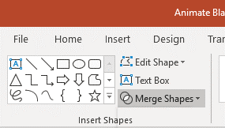Cut a Shape Out of an Image in PowerPoint Using Merge Shapes
by Avantix Learning Team | Updated September 7, 2023
Applies to: Microsoft® PowerPoint® 2013, 2016, 2019, 2021 and 365 (Windows)
In Microsoft PowerPoint 2013 and later versions, you can use Merge Shapes to mask or cut a shape out of an image. The shape could be any shape in the Shapes Gallery including a triangle, rectangle, diamond or oval. You can also create a custom shape and use it as a cut out.
To cut a shape out of an image, you'll need to:
- Insert an image onto a slide (typically in Normal View).
- Draw a shape on top of the image and move it to the area you want to cut out of the image.
- Select the image and then the shape by Shift-clicking.
- Use Merge Shapes to intersect or cut the shape out of the image.
When you are drawing or moving an object, use your left mouse button.
Note: Buttons and Ribbon tabs may display in a different way (with or without text) depending on your version of PowerPoint, the size of your screen and your Control Panel settings. For PowerPoint 365 users, Ribbon tabs may appear with different names. For example, the Picture Tools Format tab may appear as Picture Format and the Drawing Tools Format tab may appear as Drawing Format or Shape Format.
Recommended article: How to Blur an Image in PowerPoint
Do you want to learn more about PowerPoint? Check out our virtual classroom or in-person classroom PowerPoint courses >
Merge Shapes appears on the Shape Format, Drawing Format or Drawing Tools Format tab in the Ribbon when multiple objects are selected:
Merge Shapes includes the following options (hover over the options to view the effect on the selected objects):
- Union – converts the selected objects into one object.
- Combine – converts the selected objects into one object and removes the overlapping areas.
- Fragment – converts larger objects into many smaller objects based on their overlapping areas.
- Intersect – removes areas of the larger objects and leaves only the areas that overlap each object.
- Subtract – removes areas of the last selected object that does not overlap.
Step 1: Insert an image onto a slide
To insert an image from a drive onto a slide in PowerPoint 2013, 2016, 2019 or 2021:
- In Normal View, display the slide where you want to insert the image.
- Click the Insert tab in the Ribbon and select Pictures. A dialog box appears.
- Navigate to the folder with the image you want to insert.
- Double-click the image. The image will be placed on the slide.
- Drag the image to the desired location.
- Drag a corner handle of the image to resize it.
To insert an image from a drive onto a slide in PowerPoint 365:
- In Normal View, display the slide where you want to insert the image.
- Click the Insert tab in the Ribbon and select Pictures. A drop-down menu appears.
- Select This Device. A dialog box appears.
- Navigate to the folder with the image you want to insert.
- Double-click the image. The image will be placed on the slide.
- Drag the image to the desired location.
- Drag a corner handle of the image to resize it.
For other ways to insert a picture in PowerPoint 365, check out How to Insert a Picture in PowerPoint 365 from a Drive, Stock Images or Online Pictures.
Step 2: Draw a shape on top of the image
To draw a shape on top of an image:
- Click the Insert tab in the Ribbon and then click Shapes. A drop-down menu appears.
- Select the shape you want from the Shapes Gallery. The pointer changes to a plus sign.
- Position the pointer on the slide and drag to draw the shape.
- Release the mouse button.
- Select the shape.
- Click the Drawing Tools Format, Drawing Format or Shape Format tab in the Ribbon and select Shape Fill. A drop-down menu appears.
- From the menu, select No Fill. Because the shape has no fill, you'll need to select it by clicking its edge.
- Drag the shape by its edge over the area of the image that you want to cut out. You can also use your arrow keys to move the shape.
Step 3: Select the image and the shape and merge shapes
To select the image and the shape and then merge shapes:
- Click the image.
- Shift-click the edge of the shape.
- Click the Drawing Tools Format, Drawing Format or Shape Format tab in the Ribbon.
- In the Insert Shapes group, click Merge Shapes and then select Intersect from the drop-down menu.
In the following example, we selected an image and then selected a shape on a PowerPoint slide (the order in which you select the objects is important):
Below is the final result with the shape cut out of the picture using Merge Shapes and Intersect:
When you use Merge Shapes with an image and a shape, PowerPoint creates a new shape so you will not be able to uncrop the image at a later date. You can undo Merge Shapes immediately by pressing Ctrl + Z but once you close and save the file, you will no longer be able to undo the merge.
Subscribe to get more articles like this one
Did you find this article helpful? If you would like to receive new articles, JOIN our email list.
More resources
How to Align Objects in PowerPoint (4 Ways)
3 Ways to Change the Font on All Slides in PowerPoint
How to Insert a Check Mark in PowerPoint (4 Ways with Shortcuts)
How to Strikethrough or Cross Out Text in PowerPoint (4 Ways with Shortcuts)
How to Change the Background of PowerPoint Slides to a Color, Gradient or Picture
Related courses
Microsoft PowerPoint: Intermediate / Advanced
Microsoft PowerPoint: Design for Non-Designers
Microsoft PowerPoint: Animations Bootcamp
Our instructor-led courses are delivered in virtual classroom format or at our downtown Toronto location at 18 King Street East, Suite 1400, Toronto, Ontario, Canada (some in-person classroom courses may also be delivered at an alternate downtown Toronto location). Contact us at info@avantixlearning.ca if you'd like to arrange custom instructor-led virtual classroom or onsite training on a date that's convenient for you.
Copyright 2024 Avantix® Learning
You may also like
How to Insert or Type E with an Accent Mark in PowerPoint (È, É, Ê, Ë, è, é, ê, or ë)
You can insert or type e with an accent mark in PowerPoint using built-in tools or keyboard shortcuts (including Alt code shortcuts). The letter e can be inserted with an accent in both upper or lower case in text boxes or placeholders on slides, the slide master or layouts. The following are common accents in upper or lower case – È, É, Ê, Ë, è, é, ê, or ë.
How to Fade a Picture or Part of a Picture in PowerPoint (Using a Gradient)
You can fade a picture in PowerPoint by drawing a rectangle shape on top of the picture and then filling the rectangle with a gradient from opaque to transparent. This technique is often used to fade an image into the background of a slide. Since the rectangle is placed on top of the image and then text may be placed on top of the rectangle, you may need to reorder the objects.
How to Lock an Image, Shape or Other Object in PowerPoint
You can now lock an image, shape or other object in PowerPoint. Objects can be locked in Normal View or Slide Master View. Only PowerPoint 365 users can lock objects to prevent moving and resizing. This is helpful if you want to select and move other objects on the slide or prevent others from moving or resizing an object. You can lock items using the context menu or the Selection Pane.
Microsoft, the Microsoft logo, Microsoft Office and related Microsoft applications and logos are registered trademarks of Microsoft Corporation in Canada, US and other countries. All other trademarks are the property of the registered owners.
Avantix Learning |18 King Street East, Suite 1400, Toronto, Ontario, Canada M5C 1C4 | Contact us at info@avantixlearning.ca










